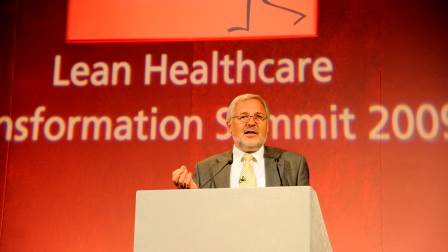I often tell audiences that I collect questions, particularly ones I have to go away and think about. I also tell them I judge the quality of the audience by the quality of the questions they ask! Their questions are invaluable in studying a field where the practice of the pioneers is way ahead of the theory of the teachers.

Over the last month I visited seven large organisations doing very different things across Europe, all actively involved in lean. What struck me was how similar their underlying questions are. In many cases the answers lie in a deeper understanding of Toyota’s management practices, but in others it is up to us to explore where lean thinking principles can lead us. How many of these eight questions resonate with your experience?
1. How to convince top management that “good processes lead to good results’? That the most effective way of closing the critical performance gaps facing an organisation is by addressing the root causes of the broken processes or value streams responsible for delivering them. By building a robust business case to show how compressing the time through these value streams translates directly into better customer fulfillment, higher margins, freed up resources and cash, lower unit costs, less capital expenditure and new business opportunities.
2. How to improve the effectiveness of complex projects while at the same time increasing the productivity of scarce engineering and management resources? From Toyota’s experience we learn that daily visual management of the progress of a project, maybe coordinated through an Oobeya room, enabling teams to respond quickly to any slippage as it happens is a more powerful driver than less frequent gate reviews or any computerised scheduling system. Visual management is as powerful in the executive office as it is in engineering or on the shop floor
3. How to develop a common way of thinking and solving problems across an organisation? Toyota’s A3 reports lay the foundation for evidence based management using the scientific method by providing a common language for prioritising, planning and problem solving at every level of the organisation. It is also the way managers throughout their careers learn to think about problems in the right way, guided by questions in a dialogue with their superiors.
4. How to engage knowledge workers to create responsive and efficient service delivery organisations, in both the private and public sectors? This is about organising the customer interface around a problem solving dialogue and developing the capabilities of those who support them to respond quickly right-first-time to changing needs. It is also opens up new possibilities for managing the customer life cycle and integrating services to help customers solve their problems cost effectively.
5. How to work across departmental and organisational boundaries to free up cash, reduce costs and improve supply chain responsiveness? Someone has to take responsibility for surfacing the consequences of excessive lead times, demand amplification and optimising the pieces rather than the whole. This is the basis for gaining agreement on doing the right things and for sharing the gains and losses along the value stream. The knowledge gained is also invaluable in designing next generation products and the much more compressed value stream to deliver them.
6. How to manage patient journeys to reduce length of stay so hospitals can treat more patients safely with existing resources? This starts with a plan-for-every-patient and the visual management of the flow of patients from admission to discharge in a way that aligns the demand to get out with the demand to get into the hospital. This needs top management focus and a value stream management team to gain agreement from all parties, including support services, on the actions necessary to enable this happen.
7. How can lean help to redesign healthcare systems and the supply chains that support them? First by analysing alternative ways of organising patient journeys, co-management of ongoing conditions and care in the community without replicating the problems encountered in managing traditional district general hospitals. Second by dramatically compressing the lead times and costs in producing and delivering all the products and services through healthcare supply chains to the point of use.
8. How can our experience with lean help to design much more cost effective systems for making new products and delivering new services in the future? Lean opens up new ways of organising and managing the work of product development, supplier coordination, production and ongoing customer support. The challenge is to synchronise them in such a way that avoids the sometimes perverse consequences of today’s planning and costing systems. Eliminating unnecessary time and cost opens up new capabilities to work with customers using the web to solve their problems on a continuing basis much more cost effectively.
Thinking about these questions led me to search for those who can best answer them, not just from theory but from practice. I have invited them to share their answers and discuss their experiences in talks and workshops at our next Lean Summit on 2-3 November 2010 in Kenilworth, near Birmingham in the UK. My hope is that this will inspire all of us to follow their examples and show us the direction our lean journeys should follow. We will post the full Summit programme shortly on our web site. I look forward to seeing you there.